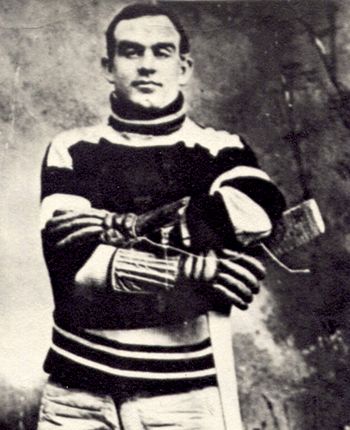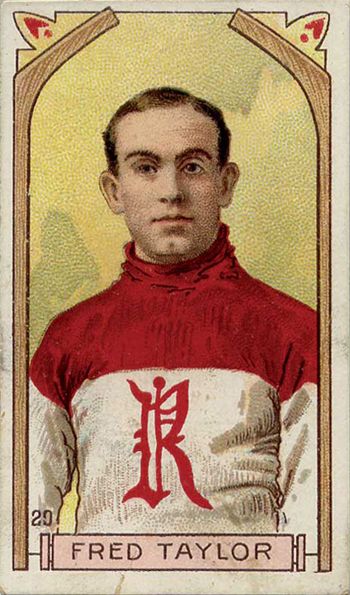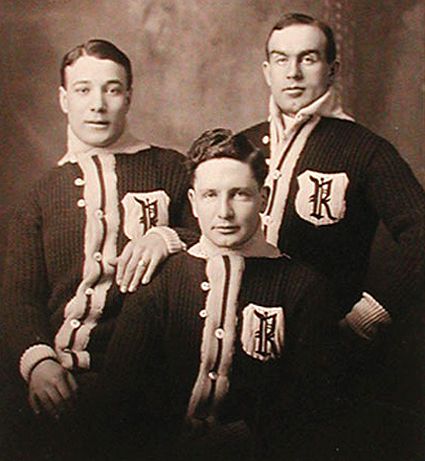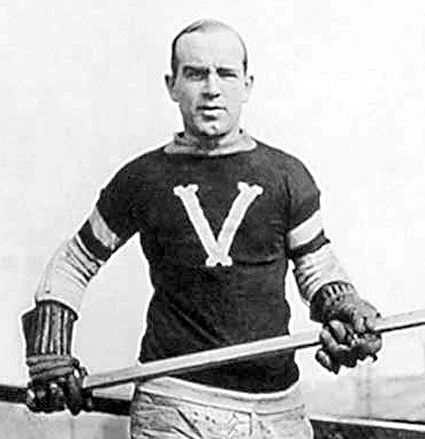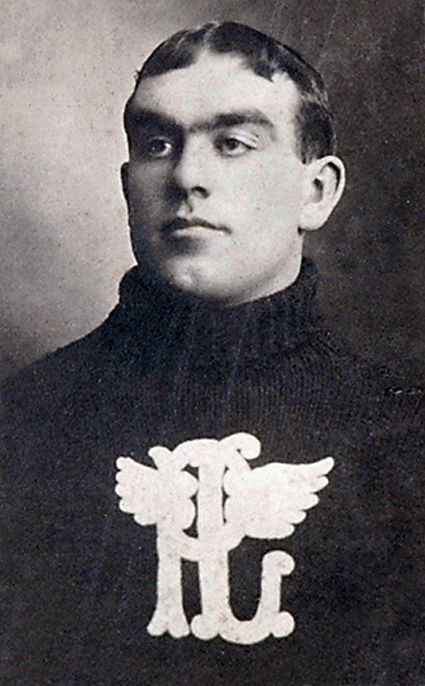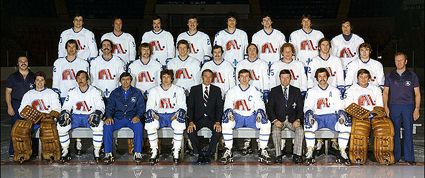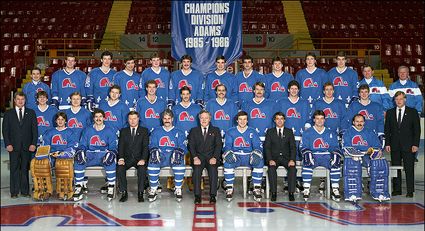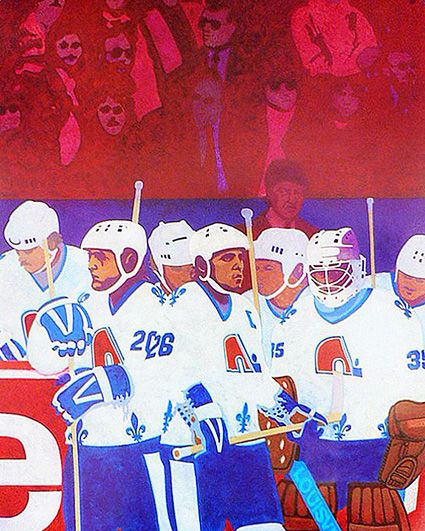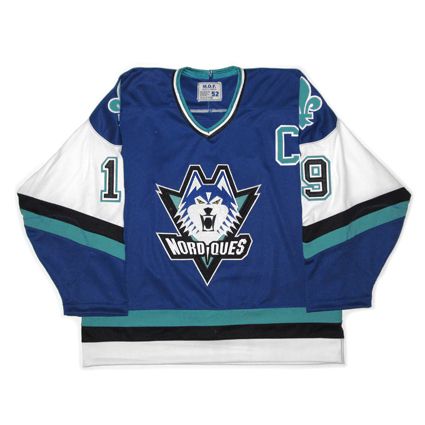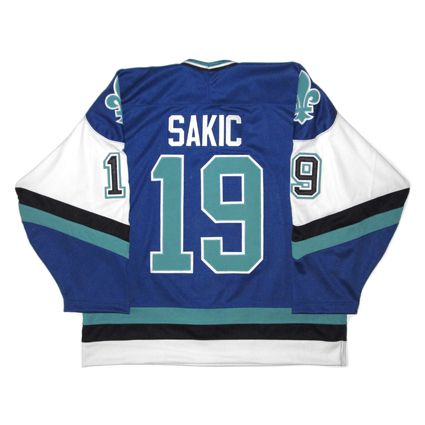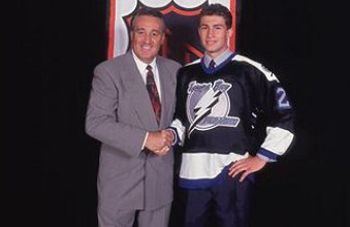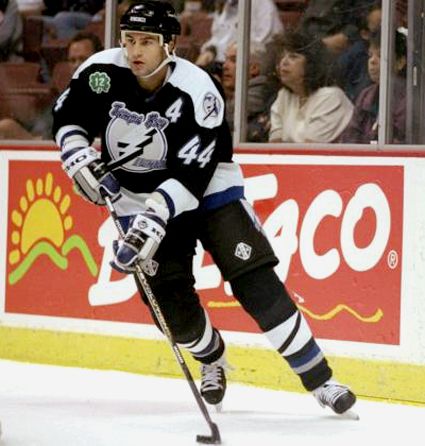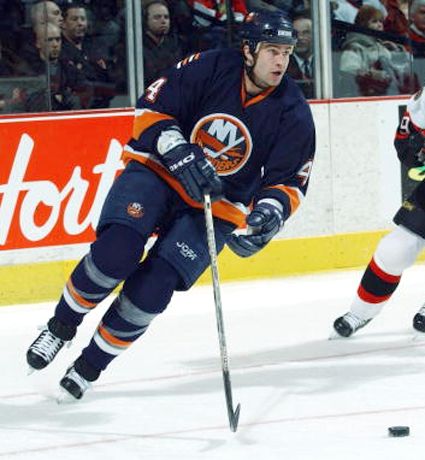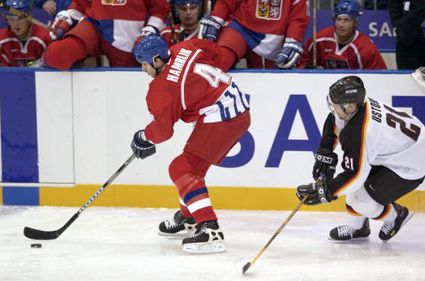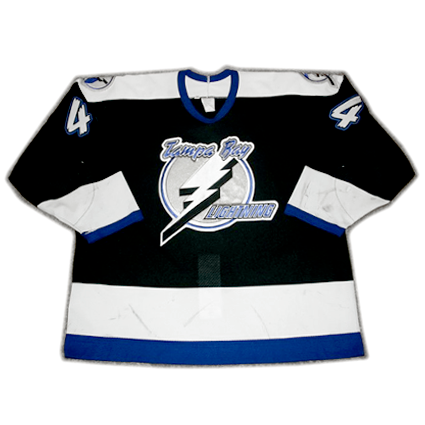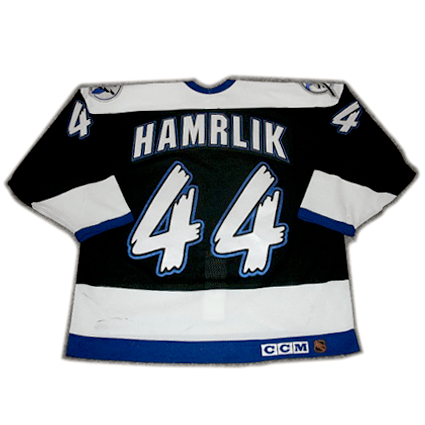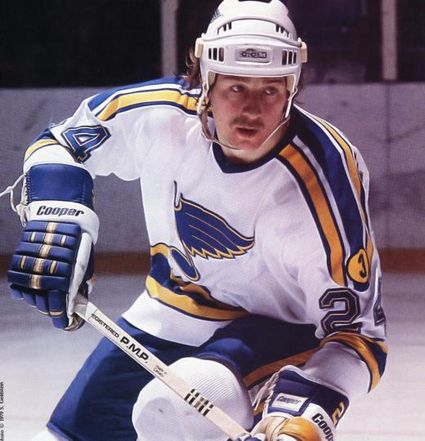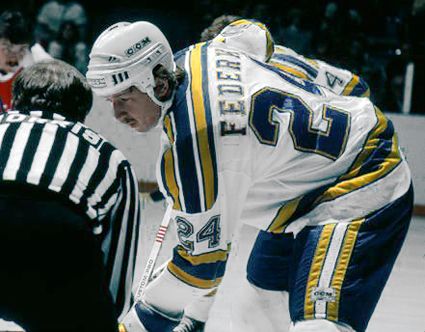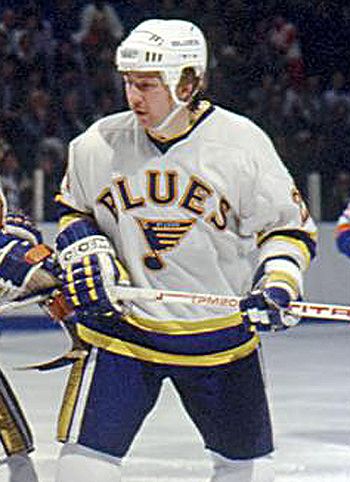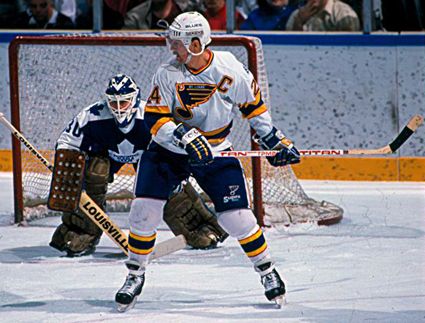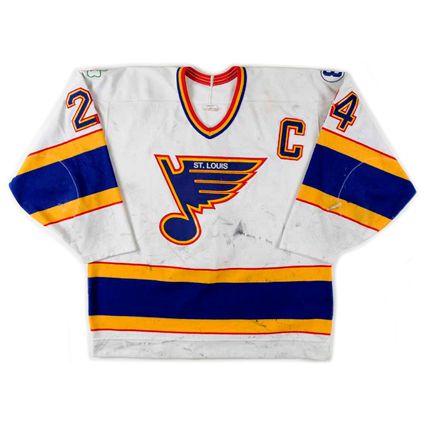Friday, June 23, 2017
1905-06 Portage Lake Hockey Club Cyclone Taylor Jersey
Born on this date in 1884, Fred "Cyclone" Taylor was one of the first stars of the fledgling sport of hockey and one of the leading scorers of his day.
As was common in the early days of organized hockey, Taylor played for several teams in several leagues - depending on where the money was. He joined his is first professional club, thanks to a $3,000 salary offer, the Portage Lakes Hockey Club in Houghton, Michigan in the International Professional Hockey League. Taylor arrived in the latter part of the 1905-06 season in time to score 11 goals in 6 games and help the club win the league championship with a 19-5 record.
He returned for the 1906-07 season and scored 14 times in 23 games as Portage Lakes again won the championship, this time with a record of 16-8. With professional teams now starting up in Canada, many of the players preferred to play closer to home and the IPHL disbanded after before the start of the next season.
Taylor moved back east, joining the Ottawa Senators of the Eastern Canada Amateur Hockey Association for the 1907-08 season. In 1908, Taylor played the start of the season with Pittsburgh of the Western Pennsylvania Hockey League but returned to Ottawa in time for the start of the Senators next season. Once back, he scored 9 goals in 11 games as Ottawa won the league title with a 10-2 record. As champions of the league, Ottawa became the holders of the Stanley Cup, previously held by league members the Montreal Wanderers.
Taylor of the Ottawa Senators
It was during this period that Canada's Governor General was so impressed with his incredible speed that he gave Taylor the nickname "Cyclone".
After a falling out with management of Ottawa, Taylor accepted an offer to join the Renfrew Creamery Kings for the inaugural season of the National Hockey Association.
There he was joined by future hall of famers Lester Patrick, his brother Frank Patrick as well as mid-season addition Newsy Lalonde. The paychecks handed out to the Renfew players earned the club the unofficial nickname of the Renfrew "Millionaires". Taylor's salary in particular was the highest ever for a Canadian athlete up to that time and remained so for many years.
Newsy Lalonde, Frank Patrick and Cyclone Taylor of Renfrew
Despite their high priced talent, Renfrew finished third in the league and reportedly lost $17,000 that season. Taylor returned for the 1910-11 season, only without the Patricks or Lalonde.
The club once again finished third in the standings and disbanded following the season, putting Taylor back on the open market. Sort of.
His rights were transferred to the Montreal Wanderers, but Taylor was quoted as saying he'd rather retire than join the Wanderers and ended up playing in a game for the Ottawa Senators. The Wanderers protested Taylor's appearance for Ottawa and won. The game was ordered replayed, Taylor and Ottawa were fined $100 each and Taylor was given an indefinite suspension, ending his 1911-12 season at one game.
In November of 1912, Taylor was lured to the Vancouver Millionaires by his former teammates the Patrick brothers, who had formed the Pacific Coast Hockey League.
Taylor with the Vancouver Millionaires in 1912-13
There, he would find a permanent home, playing the next nine seasons of his career, which included five scoring titles, thanks in part to moving up to forward from defense, a career high of 32 goals in 18 games in 1917-18 and a Stanley Cup championship in 1915 thanks to a 3 games to none win over Taylor's former club, the Ottawa Senators which included Taylor scoring six times in the three games including twice in the cup clinching Game 3. The victory by the Millionaires remains the only Stanley Cup ever won by a team from Vancouver 95 years later.
1915 Stanley Cup champion Vancouver Millionaires
The Millionaires returned to the Stanley Cup Finals in 1918, and while they fell in seven games to the Toronto Arenas, Taylor led all playoff scorers with 9 goals in 7 games.
He stopped playing hockey after the 1920-21 season, but did return for a single game in the 1922-23 season with the club now renamed the Vancouver Maroons. He finished his career averaging more than a goal per game with 194 goals in 186 regular season games.
Following his playing career, he was elected to the Hockey Hall of Fame in 1947. His son Fred Jr. opened a chain of hockey equipment stores called Cyclone Taylor Sports in 1957 which remain in operation today. Since 1967 the playoff champions of the three British Columbia Junior B hockey leagues is awarded the Cyclone Taylor Cup.
In 1979, the Canucks renamed the club's annual MVP award the Cyclone Taylor Award. There are also arenas in Vancouver and his birthplace of Tara, Ontario named in his honor as well as Cyclone Taylor Boulevard, which is one of the four roads around the current Ottawa Senators arena, Scotia Bank Place in Ottawa.
Today's featured jersey is a 1905-06 Portage Lake Hockey Club Fred "Cyclone" Taylor jersey. Or in this case we should we say "sweater". This classic turn of the century hockey sweater features a wonderful "PL" monogram adorned with wings on either side. This heavy sweater certainly would have kept the players warm, as the IPHL played it's games in the winter on natural ice.
While the Portage Lake team only existed for a limited number years, playing exhibition games as early as 1900 and joining the IPHL in 1904 when they began to attract players of note from Canada with the salaries they were paying in the days of amateur hockey, the lineup of future hall of famers was quite impressive, including IPHL founder Jack Gibson in the Builders category, "Bad" Joe Hall, goaltender Riley Hern, team captain Bruce Stuart, his brother Hod Stuart and of course the legendary Cyclone Taylor.
Today's video is a treat, a look at Taylor's career which includes an interview with the man himself!
Labels:
Portage Lake Hockey Club,
Taylor Cyclone
Wednesday, June 21, 2017
1995-96 Quebec Nordiques Joe Sakic Prototype Jersey
On this date in 1995, the NHL gave their approval for the sale of the Quebec Nordiques which resulted in their relocation to Denver, Colorado.
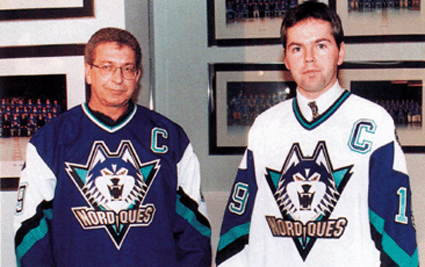
Claude Cadorette and Pierre Kirouac in the best known
photo of the Nordiques proposed new jersey style
Originally founded in 1972 as one of the original 12 WHA franchises, the Nordiques played seven seasons in the WHA, winning the championship once in 1977.
While the league folded following the 1978-79 season, four of the league's strongest and most stable franchises would enter the NHL as "expansion" franchises, which included the Nordiques.
Life in the NHL proved both exciting and difficult. The Nordiques rivalry with Quebec neighbors the Montreal Canadiens provided some of the most intense battles of the 1980's. After missing the playoffs in 1980, the Nordiques made the playoffs for seven consecutive seasons, including a division title in 1986 and a pair of trips to the conference finals in 1982 and 1985.
Sadly for fans of the Nordiques, the club fell on some very hard times after 1987, missing the playoffs six out of the next seven seasons, including a horrid run from 1988-89 to 1991-92 when the club won a total of 75 games, an average of less than 19 per season, including last place finishes in 1988-89, 1989-90 (33 points behind the second worst team, more than the 31 they actually scored!) and 1990-91.
The Nordiques used the resulting draft picks to select players such as Mats Sundin and Adam Foote (1989), Owen Nolan (1990), Eric Lindros (1991) (who they converted into Peter Forsberg, Ron Hextall, Chris Simon, Mike Ricci, Steve Duchesne, Jocelyn Thibault and $15 million) and Adam Deadmarsh (1993).
All this, in addition to the selection of Joe Sakic (15th overall in 1987), gave the Nordiques a very bright future on the ice, as evidenced by their record-setting turnaround from a 52 point season in 1991-92 to a 104 point season in 1992-93, an improvement of 52 points in one year!
All this, in addition to the selection of Joe Sakic (15th overall in 1987), gave the Nordiques a very bright future on the ice, as evidenced by their record-setting turnaround from a 52 point season in 1991-92 to a 104 point season in 1992-93, an improvement of 52 points in one year!
Unfortunately, the future did not look the same off the ice. The weak Canadian dollar hampered the bottom line, as the team's revenues came in Canadian dollars but player salaries were paid in US dollars. No doubt the small size of Quebec City worked against the team and the exclusive use of French in the city both hurt it's ability to attract certain players, Lindros in particular, sponsorships and contracts with radio and TV outlets. It's home arena, the Colisee de Quebec, built in 1949 and it's smaller 15,750 capacity also limited the team's finances.
Nordiques president Marcel Aubut sought financial help from the Quebec provincial government as well as a new publicly funded arena, all of which was turned down.
Eventually the club was sold to Comsat Entertainment Group, already owners of the Denver Nuggets of the NBA, who relocated the team to Denver, Colorado for the 1995-96 season - a year in which they proceeded to immediately win the Stanley Cup with a roster full of players selected to be Nordiques.
Eventually the club was sold to Comsat Entertainment Group, already owners of the Denver Nuggets of the NBA, who relocated the team to Denver, Colorado for the 1995-96 season - a year in which they proceeded to immediately win the Stanley Cup with a roster full of players selected to be Nordiques.
Today's featured jersey is a 1995-96 Quebec Nordiques Joe Sakic prototype jersey. The original 1972 Nordiques jerseys used light blue had a considerable amount of red on both the shoulders and waist stripe. The following season the blue was changed to a considerably darker shade and the amount of red was limited to the shoulders on the home jerseys and narrower striping.
The familiar Nordiques style was adopted in 1975 and remained in use through the Nordiques final season in Quebec twenty years later, although a new jersey with a modernized logo was unveiled on March 30, 1995 which was originally intended to be worn by the Nordiques in 1995-96.
It has been reported that the club missed the deadline for approval of the jerseys in time for the start of the 1995-96 season and the jersey was now scheduled to become the Nordiques new jerseys for the 1996-97 season, only to see the club relocate to Denver, Colorado, where they would be renamed the Avalanche, leaving the now orphaned jerseys to go forever unworn.
It has been reported that the club missed the deadline for approval of the jerseys in time for the start of the 1995-96 season and the jersey was now scheduled to become the Nordiques new jerseys for the 1996-97 season, only to see the club relocate to Denver, Colorado, where they would be renamed the Avalanche, leaving the now orphaned jerseys to go forever unworn.
The only known photo of the original jerseys shows (not very thrilled) journalist Claude Cadorette on the left in the blue road jersey and Nordiques public relations employee Pierre Kirouac on the right in the home white jersey modeling the sweaters, failing to show even the full length of the jerseys to reveal the intended waist striping.

Claude Cadorette and Pierre Kirouac in the best known
photo of the Nordiques proposed new jersey style
None of these jerseys were ever mass produced for retail sale, although some attempts to create them have been made, but none in any great quantities and some with less accurate colors than others thanks to a widely circulated illustration which had it's origins based on a guess while viewing a black and white photo. We were fortunate to obtain one of the accurately colored ones which do show up on ebay from time to time, which is today's featured jersey.
Our video section today begins with the 1984 playoffs "Good Friday Brawl" between the Nordiques and Canadiens.
Here is a report on Lindros refusal to play for the Nordiques, a stance which would eventually lead to the long-term success of the franchise - after it moved to Denver.
Finally, a video showing how the team was playing well, but financially the club was a state of financial decline.
Labels:
Quebec Nordiques
Tuesday, June 20, 2017
1995-96 Tampa Bay Lightning Roman Hamrlik Jersey
The 1992 NHL Entry Draft was held on this date in Montreal and the Tampa Bay Lightning selected defenseman Roman Hamrlik of Czechoslovakia with the first overall pick, the first Czech ever drafted #1 overall.
Hamrlik with Phil Esposito after being drafted #1 overall in 1992.
So why is the #1 pick given a jersey with the #2?
So why is the #1 pick given a jersey with the #2?
The Ottawa Senators followed with center Alexei Yashin at #2, Mike Rathje went third to the San Jose Sharks, left wing Todd Warriner fourth to the Quebec Nordiques and the New York Islanders rounded out the top five with the rugged Darius Kasparitis, making three defensemen among the top five.
Other notable selections in the first round were Cory Stillman at #6 to the Calgary Flames, Sergei Gonchar went 14th to the Washington Capitals and long-time NHLers Martin Straka 19th to the Pittsburgh Penguins and Grant Marshall 23rd to the Toronto Maple Leafs.
Later round successes were Michael Peca at #40 to Vancouver, Darren McCarty #46 to Detroit, #65 Kirk Maltby to Edmonton, #88 Jere Lehtinen to the Minnesota North Stars, Adrian Aucoin #117 to Vancouver, the indestructible Ian Laperriere to St. Louis at #158, Stephane Yelle at #186 in round 8 to New Jersey and future NHL All-Stars Nikolai Khabibulin #204 in Round 9 to Winnipeg and in Round 10, Anson Carter, #220, to Quebec.
The latest pick to see NHL action was Andrei Vasilyev (#248) who played 16 games over four seasons with the Islanders (15) and the Phoenix Coyotes (1).
Hiroyuki Miura became the first Japanese player drafted at #260 in the 11th and final round, if you don't count the fictitious Taro Tsujimoto taken in 1974 by Punch Imlach of the Buffalo Sabres! Miura played six games with the Wheeling Thunderbirds of the ECHL in 1993-94, but never came close to playing in the NHL.
Hamrlik made his NHL debut later in 1992 with the Lightning and played in 67 games and scored 21 points. He maintained his scoring pace the next season, but raised his toughness level, nearly doubling his penalty minutes from 71 to 135. Three more seasons in Tampa followed, including a career high 16 goals and 65 points in 1995-96, until Hamrlik was traded to the Edmonton Oilers halfway through the 1997-98 season as part of a five player trade.
Two and a half seasons in Edmonton were followed by a trade to the New York Islanders, where he played for four full seasons. He spent the lockout season of 2004-05 like many other European NHLers by returning to the final club he played for prior to moving to North America, in Hamrlik's case, ZPS in Ziln of the Czech Republic.
With the lockout concluded, Hamrlik signed with the Calgary Flames as a free agent for two seasons prior to choosing the Montreal Canadiens as his next home beginning in 2007-08. He would play four seasons in Montreal before a move to the Washington Capitals for all of 2011-12. Once the lockout ended, he saw action in f4 games with the Capitals before being claimed by the New York Rangers in March, where he finished out his career with a final 12 games.
Hamrlik scoring against his old team, the Islanders, while with Montreal
A major reason for Hamrlik's lengthy NHL career was his remarkable consistency. From 1994 through 2011, Hamrlik has scored between 21 and 46 points, save for the one season he hit 65. He has also missed a minimum of games, a stretch of 14 of 15 NHL seasons playing 70 games or more from 1995-96 to 2011-12, a streak ended when he played "only" 68 games.
Internationally, his opportunities were somewhat limited by his regular appearances in the NHL playoffs, but Hamrlik as competed for the Czech Republic in the 1994 World Championships, the 1996 World Cup, the 1998 Olympics where he won a gold medal, the 2002 Olympics, the 2004 World Championship and the 2004 World Cup. Prior to his North American career, he played for Czechoslovakia in the 1991 and 1992 European U18 World Championships, winning gold twice and the 1992 World Juniors.
Thanks to his longevity, he finished his career with 1,395 games played, 638 points from 155 goals and 483 assists.
Today's featured jersey is a 1995-96 Tampa Bay Lightning Roman Hamrlik jersey as worn during his highest scoring season when he scored a career high 16 goals and 65 points. He also made his first appearance in the NHL playoffs that season.
This style Lightning jersey was originally worn in their debut season of 1992-93 with a silver numbers and a blue drop shadow and a unique font for the names on the back. The following season the fonts were italicized, making for the best looking Lightning jerseys in their history.
For some reason, the club changed to radially arched letters and the now white paintbrush font numbers, which have little to do with the name "Lighting", after only just one season. This style remained in use through the 1999-2000 until they changed to a much more boring block style font and one color names with no arching or any other feature to make them unique, as all other Lightning fonts had been throughout their history up until this point. It's a change we've never understood, considering their past history of unusual choices.
Today's video section begins with Hamrlik being selected first by the legendary Phil Esposito.
Next, Hamrlik converts the world's best saucer pass by Tomas Plekanec after Plekanec skates the length of the ice through the entire Islanders team to win the game in overtime.
Finally, highlights of Hamrlik's time with both Calgary and Montreal, set to the typical YouTube soundtrack. No penalty points for turning your speakers off.
Labels:
Hamrlik Roman,
Tampa Bay Lightning
Monday, June 19, 2017
1988-89 St. Louis Blues Bernie Federko Jersey
Starting his path to the NHL with the Saskatoon Blades of the WHL in 1973-74, Bernie Federko made an immediate impact as a 17-year-old with 22 goals and 50 points. Those totals rose to 39 goals and 107 points in 1974-75 before a dominating season in which Federko scored an amazing 72 goals in 72 games while recording an additional 115 assists to set a team record with 187 points which still stands today.
He also led the league in scoring on his way to MVP honors that season, which caught the attention of scouts in both the NHL and the WHA, leading to Federko being drafted 6th overall by the Edmonton Oilers of the WHA and 7th overall by the St. Louis Blues of the NHL.
Federko opted to sign with St. Louis, who sent him to play with the Kansas City Blues of the Central Hockey League. After 42 games with Kansas City, he was leading the league in scoring with 30 goals and 69 points when summoned by St. Louis to make his NHL debut. He would play in the final 31 games of the year with the Blues, scoring 14 goals and 23 points. Despite not finishing the season in Kansas City, Federko was named the CHL Rookie of the Year.
Federko would never play another game in the minors once he was called up, and finished a second season with St. Louis at a very similar scoring pace, finishing with 41 points in 72 games, good for second on the team behind Gary Unger's 52.
Now fully settled in to the NHL, Federko unleashed his offensive game in 1978-79, scoring 31 goals and 95 points to lead the Blues in scoring for the first of eight consecutive seasons.
He pushed his goal total up to 38 the following season with a nearly identical 94 points which led to his first NHL All-Star Game appearance. 1980-81 saw him achieve his first 100 point season when he tallied 104 points for his third consecutive top ten finish in league scoring and a second consecutive NHL All-Star Game appearance.
A fourth straight 30 goal season came in 1981-82 followed by a somewhat down year for Federko, as he was held to 24 goals and 84 points in 1982-83, but rebounded in 1983-84, as he set career highs with 41 goals and 107 points to once again return to the top ten scorers in the NHL.
After a 30 goal, 103 point campaign in 1984-85, his seventh 30 goal season came in 1985-86 with 34 goals and his fourth 100 point season with 102. The Blues would qualify for the playoffs for the seventh consecutive season and make the deepest run of Federko's career, as they would reach the conference finals while Federko scored 7 goals and 21 points in 19 games.
The 1986-87 season saw him finish second in scoring for St. Louis to Doug Gilmour when Federko was limited to 64 games and 72 points. He rebounded with 89 points in 79 games in 1987-88, which included the 1,000th point of his NHL career on March 19, 1988, but time was catching up to Federko.
Despite a decline in his offensive numbers, his final season in St. Louis saw him named as the Blues team captain and still producing at a point per game, with 22 goals and 67 points in 66 games. He'd finish his career in St. Louis with 4 goals and 12 points in 10 playoff games, his 10th consecutive postseason with the Blues.
Prior to the start of the 1989-90 season, Federko and Tony McKegney were traded to the Detroit Red Wings for Paul MacLean and Adam Oates.
Federko, a center, was re-united with his former Blues head coach Jacques Demers, but was behind Steve Yzerman on the Red Wings depth chart. This resulted in a cutback on his ice and power play time, resulting in 17 goals and just 57 points, his lowest in 12 seasons, leading him to retire with exactly 1,000 NHL games played.
Federko's final NHL totals were 1,000 games played, 369 goals and 761 assists for 1.130 points and Blues team records for Career Games Played (927), Career Assists (721), Career Points (1,073) and Career Playoff Assists (66).
Federko had his number 24 retired by the Blues in 1991 and was announced as a new member of the Hockey Hall of Fame in on this date in 2002.
Today's featured jersey is a 1988-89 St. Louis Blues Bernie Federko jersey as worn during his final season in St. Louis when he served as the Blues team captain.
This is an amazing example of a Blues jersey, as it not only has the captain's "C", but also a pair of memorial patches, the #8 on the left shoulder for Barclay Plager and the "DK" shamrock for long time Blues broadcaster Dan Kelly.
The Blues adopted this basic jersey style in 1984-85, which featured a darker shade of blue and the name "BLUES" arched over the blue note crest. After three seasons, the wordmark was dropped, leaving just the blue note once again. This new version of the Blues jersey was worn for the final two seasons of Federko's career and seven seasons overall.
He also led the league in scoring on his way to MVP honors that season, which caught the attention of scouts in both the NHL and the WHA, leading to Federko being drafted 6th overall by the Edmonton Oilers of the WHA and 7th overall by the St. Louis Blues of the NHL.
Federko opted to sign with St. Louis, who sent him to play with the Kansas City Blues of the Central Hockey League. After 42 games with Kansas City, he was leading the league in scoring with 30 goals and 69 points when summoned by St. Louis to make his NHL debut. He would play in the final 31 games of the year with the Blues, scoring 14 goals and 23 points. Despite not finishing the season in Kansas City, Federko was named the CHL Rookie of the Year.
Federko would never play another game in the minors once he was called up, and finished a second season with St. Louis at a very similar scoring pace, finishing with 41 points in 72 games, good for second on the team behind Gary Unger's 52.
Federko in 1977-78 with the #3 memorial patch for Bob Gasoff
Now fully settled in to the NHL, Federko unleashed his offensive game in 1978-79, scoring 31 goals and 95 points to lead the Blues in scoring for the first of eight consecutive seasons.
He pushed his goal total up to 38 the following season with a nearly identical 94 points which led to his first NHL All-Star Game appearance. 1980-81 saw him achieve his first 100 point season when he tallied 104 points for his third consecutive top ten finish in league scoring and a second consecutive NHL All-Star Game appearance.
Federko lining up for a faceoff
A fourth straight 30 goal season came in 1981-82 followed by a somewhat down year for Federko, as he was held to 24 goals and 84 points in 1982-83, but rebounded in 1983-84, as he set career highs with 41 goals and 107 points to once again return to the top ten scorers in the NHL.
After a 30 goal, 103 point campaign in 1984-85, his seventh 30 goal season came in 1985-86 with 34 goals and his fourth 100 point season with 102. The Blues would qualify for the playoffs for the seventh consecutive season and make the deepest run of Federko's career, as they would reach the conference finals while Federko scored 7 goals and 21 points in 19 games.
The 1986-87 season saw him finish second in scoring for St. Louis to Doug Gilmour when Federko was limited to 64 games and 72 points. He rebounded with 89 points in 79 games in 1987-88, which included the 1,000th point of his NHL career on March 19, 1988, but time was catching up to Federko.
Despite a decline in his offensive numbers, his final season in St. Louis saw him named as the Blues team captain and still producing at a point per game, with 22 goals and 67 points in 66 games. He'd finish his career in St. Louis with 4 goals and 12 points in 10 playoff games, his 10th consecutive postseason with the Blues.
Federko was the Blues captain in 1988-89
Prior to the start of the 1989-90 season, Federko and Tony McKegney were traded to the Detroit Red Wings for Paul MacLean and Adam Oates.
Federko, a center, was re-united with his former Blues head coach Jacques Demers, but was behind Steve Yzerman on the Red Wings depth chart. This resulted in a cutback on his ice and power play time, resulting in 17 goals and just 57 points, his lowest in 12 seasons, leading him to retire with exactly 1,000 NHL games played.
Federko's final NHL totals were 1,000 games played, 369 goals and 761 assists for 1.130 points and Blues team records for Career Games Played (927), Career Assists (721), Career Points (1,073) and Career Playoff Assists (66).
Federko had his number 24 retired by the Blues in 1991 and was announced as a new member of the Hockey Hall of Fame in on this date in 2002.
Today's featured jersey is a 1988-89 St. Louis Blues Bernie Federko jersey as worn during his final season in St. Louis when he served as the Blues team captain.
This is an amazing example of a Blues jersey, as it not only has the captain's "C", but also a pair of memorial patches, the #8 on the left shoulder for Barclay Plager and the "DK" shamrock for long time Blues broadcaster Dan Kelly.
The Blues adopted this basic jersey style in 1984-85, which featured a darker shade of blue and the name "BLUES" arched over the blue note crest. After three seasons, the wordmark was dropped, leaving just the blue note once again. This new version of the Blues jersey was worn for the final two seasons of Federko's career and seven seasons overall.
Today's video section is a compilation of career highlights from Federko.
Labels:
Federko Bernie,
St. Louis Blues
Subscribe to:
Comments (Atom)

